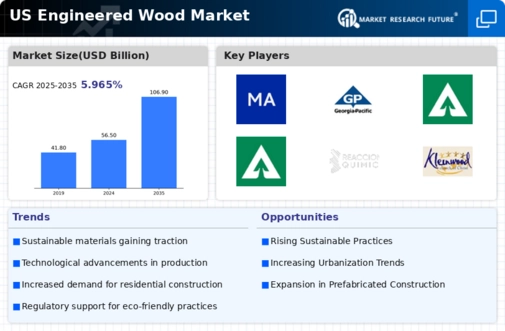US Engineered Wood Market Summary
The US Engineered Wood market is projected to grow from 56.5 billion USD in 2024 to 106.9 billion USD by 2035.
Key Market Trends & Highlights
US Engineered Wood Key Trends and Highlights
- The market is expected to achieve a compound annual growth rate of 5.97 percent from 2025 to 2035.
- By 2035, the market valuation is anticipated to reach 106.9 billion USD, indicating robust growth potential.
- In 2024, the market is valued at 56.5 billion USD, reflecting a strong foundation for future expansion.
- Growing adoption of sustainable building practices due to environmental concerns is a major market driver.
Market Size & Forecast
| 2024 Market Size | 56.5 (USD Billion) |
| 2035 Market Size | 106.9 (USD Billion) |
| CAGR (2025-2035) | 5.97% |
Major Players
Moody's Analytics, GeorgiaPacific, Weyerhaeuser, LouisianaPacific Corporation, Plum Creek Timber, Ranbar, Universal Forest Products, Kleinwood, Arauco, Koppers Holdings, Huber Engineered Woods, Advanced Environmental Recycling Technologies, West Fraser Timber, Medford Corporation, Norbord



















